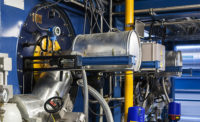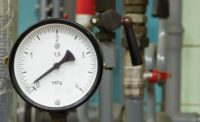Imagine that we have a 40-year-old automobile and decide to replace the engine, hoping to get another four decades of trouble-free operation. The flaw in our logic is that we have overlooked the other components of the system, such as transmission, electrical, exhaust, and body. These other components have the same mileage and amount of wear that the engine had. This analogy is similar to expecting the same results when replacing just the boiler on a project and ignoring the rest of the system.
Why are they replacing the boiler? I believe that we need to know why they are replacing the boiler because if we ignore the reason for the replacement, the new boiler could suffer the same fate. It is rare that someone replaces a boiler simply due to the age of the unit. It is usually for some other reason such as leaks, reliability, or parts availability.
Energy Savings
I smile when someone suggests that the new boiler will pay for itself with energy savings, as the payback period for a new boiler will easily take five or more years.
Distribution
When replacing the boiler, we are connecting the new boiler to pipes and flue that are in most instances original to the building. We have no idea about the condition of the piping. If the boiler failed from internal corrosion due to fresh water introduced to the system, that same corrosion would have attacked the system piping as well. This is especially true for steam systems.
Water meter
There is a common adage in business that says, “If you cannot measure it, you cannot manage it.” That same holds true for boilers. I recommend installing a water meter on the makeup water to the system. In this way, the owner knows if the system is losing water and making up fresh water. Fresh water made up into a heating system is a boiler killer. It will destroy the boiler in a relatively short time.
Pumps
These systems use pumps to distribute the Btu’s generated in the boiler to the building. According to ASHRAE, a pipe-mounted pump will last 10 years and a base mounted pump will last 20 years. I prefer to replace the system distribution pumps when replacing the boiler because I know that the new ones will be properly sized for the new boiler. A school in my area had a 20-year-old leaking boiler and wanted a price to replace it. “Why did it fail?” I asked the maintenance director. He suggested that it was 20 years old. Upon investigation, I found that the system pump had been replaced a few years ago with one that was half the size because it was less expensive. This caused the boiler to have a temperature rise that was double the manufacturer’s suggested rise. I asked if the boiler made noise when it operated and the director said it sounded like a whale howling but thought that was normal. The customer had to replace the pump and the boiler.
Another common problem with pumps is when a VFD is installed to reduce the pump speed and operating costs. If designed properly, they do lower energy consumption. “We saved lots of money with that,” the facilities man said as he pointed to the drive installed on the wall next to the pump disconnect. I wondered if the savings would be enough to pay for the boiler replacement they had to now do because the low flow ruined the boiler. When designing or installing a VFD for a pump, always check with the boiler manufacturer to verify that the boiler has the proper flow.
Primary secondary application
Many of the new boilers suggest using a primary secondary arrangement for the piping. I have found that VSD work best when installed on the pump for the primary hydronic loop that feeds the building. The pump flow on the secondary loop feeding the boiler should be verified with the equipment manufacturer. If the flow is inadequate, it could damage the new boiler.
Maintaining the system
When designing a system, you could have the best system in the world but you have to consider the weakest link. The weakest link could be the person maintaining or, in this case, not maintaining that system. An engineer friend designed a state-of-the-art system for his church pro bono that included modulating condensing boilers, a digital control system, and variable-speed pumps. He was well respected and one of the leaders for the congregation. He wanted a system that would lower the fuel costs which were rather high. About three years after the installation, he called me to look at the system since the fuel bills were rising again and the building had all the windows open in the winter.
When we arrived at the facility, the system was running wild, cycling on the limit controls. The condensing boilers were running at 180?F even though it was only about 40?F outside, which meant that they were not condensing. All the controls were running by hand instead of automatic. When we asked the custodian why, he shrugged and said that the service cost was more than they could afford so they disabled the control systems to get heat to the building. They had no money in the budget for maintenance. My friend had the board authorize the cost for the maintenance and then also trained the custodians about how to properly maintain the system. When designing a new system, I like to include a training seminar for the owner’s personnel, and we record it so they can have it for future reference.
Flue
If you are considering a new boiler that does not vent through the existing chimney, the fate of the remaining gas fired appliances that are still using the old chimney has to be considered. These remaining appliances, most commonly a water heater, are referred to as “orphans.” The industry has a guideline for dealing with these orphans. It is called the “Seven Times Rule” and it stipulates that the flow area of the largest common vent or stack shall not exceed seven times the area of the smallest draft hood outlet. Since most water heaters use a 3-in flue, the largest area to connect the water heater should be 49 in in area or a 7-in round one. You may have to change the venting of the old water heater or install a flue liner for it.
Horizontal vs. vertical flue
Another rule to remember is that the horizontal vents must be no more than 75% of the vertical height of the flue. If using B Vent, the horizontal length can be the same length as the height of the chimney, as per International Fuel Gas Code, 2006 503.10.9.
Combining the vents
When installing new condensing boilers, most units have a pressurized flue. That means that they cannot be combined in a single flue or chimney because the positive flue gases could leak out of the idle boilers into the building. Each boiler will require a separate flue and possibly combustion air pipe. As a result, the outside wall may look like the side of an old pirate ship, peppered with flue and combustion air pipes.
Sidewall vents
In an existing building, this could be difficult, as the codes for sidewall venting may be difficult to follow. For example, when venting the flue horizontally through a wall, the International Mechanical Code calls for the vent to be at least 4 ft below, 4 ft horizontally from, and 1 ft above any door, window, or gravity air inlet to the building. This may be impossible if the wall is filled with windows or fresh air intakes. This is only one of six requirements for sidewall venting.
Controlling the old system
When replacing the boiler, I like to look at what controls were added to or installed during the life of the boiler. The controls may range from a simple outside air reset control to zone valves, mixing valves, or individual radiator valves.
Outdoor air reset
Rarely do I see a hydronic boiler without some sort of reset control. The most common reset schedule features a one-to-one ratio which means that for every degree change in outside temperature, there is a one degree change in the loop temperature. For example, the system may have been designed to supply 180?F water to the building at the outdoor design temperature. As the outdoor temperature warms, the loop temperature cools. The typical one-to-one ratio will look like the following table.
The drawback to a reset control is that there is no feedback from the building and we could have the Goldilocks Syndrome, in that we do not know if the temperature being supplied is too warm, too cool, or just right. The other disadvantage to a reset control is that the water may be too cool for the boiler. The flue gases in older noncondensing boilers will start to condense when the water temperature falls below 140?F. If the flue gases condense, acids could form and destroy the boiler, flue, and chimney. If the new boiler is a condensing boiler, this will not matter.
Zone or Isolation valves
These could cause many headaches, as they affect the operation of the system. For example, if the system has three zone valves and only has one open, all of the flow will be zooming through that single zone and it could cause erosion of the system and in some instances, the flow could be so high that the system does not give up its heat. The other consideration is what happens when all the zone valves are closed. Will it let the pump know or will it cause the pump to dead head, possibly damaging it? A pump operating with closed valves could heat the water by 50?F or more per hour, creating a dangerous condition. Zone valves on low pressure steam systems could cause many issues as well. Vacuum in the piping or quick opening valves can pull the water from the boiler.
Boiler isolation valves
These valves could cause service issues if they shut off too quickly after the burner stops firing, allowing the manual reset limit control to trip, causing a “no heat” call. When a burner shuts off, the hot surfaces inside the boiler will continue to heat the water. If using boiler isolation valves, a time delay should be incorporated that will allow the heat to be distributed to the building loop before shutting off the flow.
Mixing or diverting control valves
These could be problematic as they may cause thermal shock in the boiler. A mixing valve has two inlets and one outlet. It will mix the two temperatures to get the desired outlet temperature. A diverting valve has one inlet and two outlets. It will be used to send the water one way or another. Thermal shock is when the temperature rise through the boiler is greater than the boiler manufacturer requires. Older boilers were designed for a 20 to 30?F temperature rise. If the temperature is too high, it could shake the boiler apart by the rapid expansion and contraction, causing leaks or damage to the boiler.
Radiator control valves
These could cause some of the same issues as the zone valves. In addition, radiator valves on low pressure steam systems could cause a vacuum to form in the piping. If using these valves on low pressure steam systems, be sure that vacuum breakers are installed.
Near-boiler piping
This is crucial on a steam boiler, as it is used to dry the steam before it is introduced to the building. Many manufacturers also require a steam pipe riser of at least 24 in above the water line before entering the steam header. This may be difficult in some older buildings due to the height of the ceiling.
Sizing the replacement low-pressure steam boiler
This is different than sizing a hydronic system. The hydronic system is sized using a heat loss calculation of the building. If you use this technique for a low-pressure steam system, you will have a very unhappy customer as the system will not work properly. To properly size a steam system, you have to calculate all of the connected load. This includes all the radiators as well as the system piping.
Control setting
Ever since December 1899, all low-pressure steam systems were designed to heat the building using two pounds of steam pressure or less. As a matter of fact, the Empire State Building, with a height of 1,250 ft and 102 stories, uses only two pounds of steam to heat the building. If the control is set higher than that, you need to investigate why. It could be system issues or just lack of understanding by the person maintaining the system. I have seen some buildings that use a steam-to-water heat exchanger requiring slightly higher steam pressures.
Water treatment
Waste treatment is crucial for any replacement boiler. I like including the customers’ water treatment representative in on the discussion. For example, if the owner is looking at an aluminum boiler, the water treatment for that will be different than a steel or cast iron boiler, and the treatment representative should know that. The water treatment will also be different if the system is a steam or hydronic system. A hydronic system may use a pot-type sidearm feeder that will be used to introduce the water treatment. The low pressure steam system will typically require injection pumps that will feed the chemical into either the boiler feed tank or into the steam supply to the building.
Condensate versus boiler feed
One of the most common forgotten issues we see on replacement steam boiler projects is that the customer will have to replace the condensate tank with a boiler feed unit. A condensate tank is a small tank that has an internal float that will operate the pump feeding water to the boiler whenever the level is high enough in the tank regardless of the water level inside the boiler. A boiler feed tank is usually much larger and will only feed water to the boiler when it receives a signal from the boiler. Another advantage to a boiler feed system is that the makeup water will be preheated and treated prior to being sent to the boiler.
Good luck when replacing the engine on your heating system.








